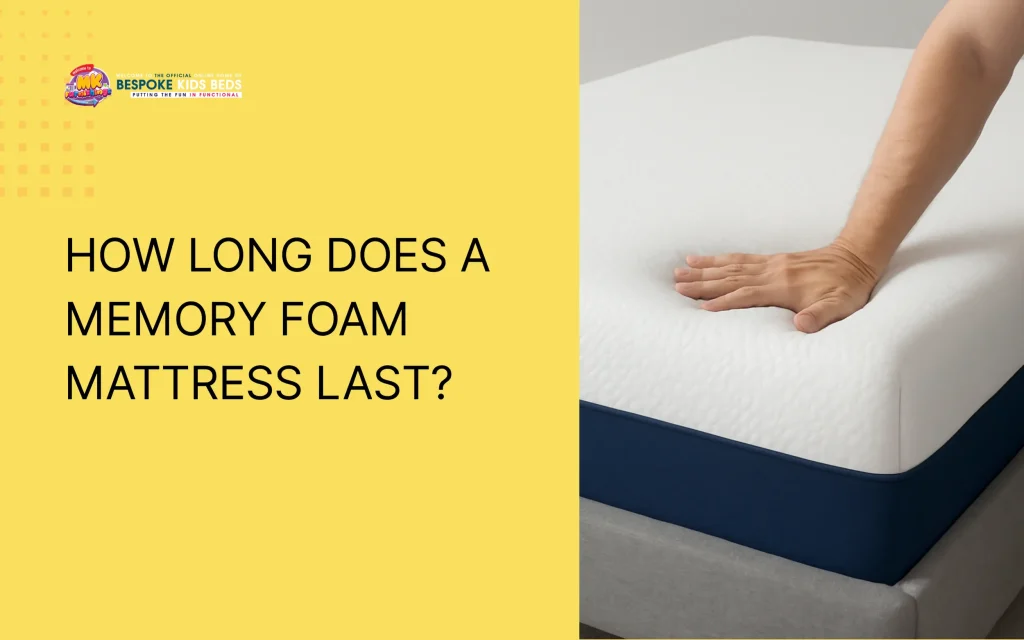
How High Is a High Sleeper Bed?
A high sleeper bed measures between 170 cm and 200 cm in total height, depending on the model and design. These beds create usable space
Enjoy FREE Delivery on All Orders!

A memory foam mattress lasts between 7 and 10 years, depending on factors such as foam quality, frequency of use, and maintenance habits. High-density foams used in quality memory foam mattresses tend to preserve their structure and comfort longer, while low-density foams may lose shape due to regular wear and tear. The overall mattress lifespan depends on how well it supports body alignment over time and how evenly it distributes pressure during sleep.
Proper care can significantly extend the life expectancy of a mattress. Rotating it every few months, using a mattress protector, and ensuring a stable bed frame help maintain its original shape and comfort. For example, a well-cared-for mattress used nightly may last close to a decade, whereas poor maintenance can reduce that to only six years. Investing in a memory foam mattress that lasts longer ensures both comfort and value for your sleep quality.
The lifespan of a memory foam mattress is influenced by several key factors, including foam density and quality, frequency of use, body weight and sleeping position, and maintenance practices. High-density, well-constructed foam resists sagging and maintains its supportive structure over time, while lower-quality materials may soften or lose resilience more quickly. Consistent care and balanced usage play an essential role in preserving comfort and performance. By understanding these elements, you can extend the lifespan of a memory foam mattress and make a smarter long-term investment.
Foam density is one of the strongest indicators of mattress durability. High-density foam, typically weighing 5 pounds per cubic foot or more, maintains better structural integrity and resists sagging even after years of use. Lower-density foam, generally below 3 pounds per cubic foot, tends to break down faster, resulting in body impressions and a noticeable loss of support. Memory foam certified by CertiPUR-US standards ensures that the materials are free from harmful chemicals and built to deliver long-lasting performance.
Different types of material in memory foam mattresses include:
The frequency of use affects the rate of mattress wear and plays a major role in how long a memory foam mattress maintains its shape and support. A mattress that is used every night endures constant compression, heat retention, and pressure, which gradually reduce the elasticity of the foam layers. Over time, this daily strain causes the material to soften and lose its original structure.
In contrast, a mattress used occasionally in a guest bedroom experiences less stress and retains firmness for a longer period. Balancing daily use with proper care, such as occasional rotation and adequate mattress support, helps preserve structure and comfort. Consistent yet mindful use can extend the mattress’s lifespan and maintain its supportive qualities over time.
Proper maintenance plays a critical role in extending the life of a memory foam mattress. Regular care keeps the foam clean, balanced, and breathable while preventing early sagging. Rotating the mattress distributes body weight evenly and minimises surface depressions. A waterproof and breathable protector guards against spills, sweat, and moisture damage, which can deteriorate foam quality. Vacuuming removes dust and allergens that collect on the surface, maintaining hygiene and airflow.
Maintenance checklist includes:
To extend a memory foam mattress’s lifespan, use a protective cover, rotate it regularly, maintain proper support with a sturdy bed frame, and avoid jumping or placing excessive pressure on one area. Cleaning it with a vacuum and baking soda, and occasionally airing it out, also helps maintain freshness and prevent odour buildup. These actions protect the internal foam layers, keeping them firm, hygienic, and evenly supported.
Rotating the mattress 180 degrees every 3 to 6 months prevents uneven wear and helps maintain consistent support across the entire surface. Sleeping in the same spot every night can cause certain foam layers to soften faster, leading to dips or uneven firmness. Rotating the mattress distributes pressure evenly, allowing the foam to recover and retain its structure for longer periods.
Tip: Use calendar reminders to keep a regular rotation routine and try combining rotation with surface cleaning for the best results.
A mattress protector prevents stains, moisture, and premature wear that can shorten a mattress’s lifespan. Acting as a barrier between the sleeper and the mattress, a protector keeps sweat, body oils, and accidental spills from penetrating the foam layers. Choosing a waterproof, breathable, and hypoallergenic protector helps maintain airflow while ensuring hygiene and comfort. Additionally, a durable protector helps avoid the need to replace your memory foam mattress prematurely and contributes to better sleep quality through cleaner, more comfortable conditions.
Protector benefits:
Cleaning your mattress prevents dust mites and stains that accumulate over time. A clean mattress not only supports a healthier sleeping environment but also preserves the internal foam structure. Regular vacuuming removes surface debris, while gentle spot cleaning keeps the fabric fresh and free from buildup. Furthermore, proper cleaning preserves the original shape of the mattress and prevents the foam from deteriorating, ensuring consistent comfort and extended longevity.
Here is a cleaning checklist you can follow:
A memory foam mattress needs replacing every 7 to 10 years or sooner if there are signs of sagging, discomfort, loss of support, and pain. Over time, the material used for a mattress may lose its ability to return to its original shape, creating body impressions that affect spinal alignment. This leads to disrupted sleep, tossing and turning, or even consistent back pain. Recognising these signs early helps maintain proper sleep quality and overall health. If the mattress no longer feels supportive, shows visible sagging, or contributes to morning stiffness, it is likely time to consider a replacement.
Visible sagging is a sign of mattress degradation and one of the most obvious indicators that replacement is needed. When a mattress develops deep body impressions or uneven surfaces, it no longer provides proper spinal alignment. Over time, these indentations prevent the foam from adapting to the body’s shape, leading to discomfort and disturbed sleep.
A simple way to check is by measuring the depth of the sagging area. If the indentation exceeds 1.5 inches, the mattress has likely lost its supportive structure. Lumps, dips, or soft spots across the surface also signal deterioration. A good memory foam mattress should maintain uniform firmness, so visible wear is a clear sign that the foam layers have weakened and can no longer deliver balanced comfort.
Health issues may indicate the need for a mattress replacement, especially when poor sleep or physical discomfort becomes frequent. As foam loses resilience, the body no longer receives adequate support, which can lead to back pain, neck tension, and overall fatigue. Inconsistent pressure distribution may also cause numbness or restless sleep, prompting more tossing and turning during the night.
If you wake up sore, feel increased stiffness, or notice reduced sleep quality, the mattress may no longer align with your body’s natural posture. A quality memory foam mattress should relieve pressure points, not create them. When these symptoms persist despite other lifestyle adjustments, replacing the mattress is essential for restoring comfort, posture, and healthy sleep cycles.
Memory foam mattress types include traditional, gel-infused, and hybrid, which directly influence comfort, durability, and support. High-density foam models provide better structure and longevity, while low-density foams offer a softer feel but may wear out more quickly. Hybrid designs combine memory foam with pocketed coils to enhance support and airflow. The average lifespan of each type varies, but higher-quality materials and thoughtful construction consistently deliver longer-lasting performance and improved comfort.
High-density foam and low-density foam are often compared to highlight differences in durability, comfort, and cost. High-density foam, usually rated at 5 pounds per cubic foot or more, provides superior longevity and firm support that contours to the body without sagging. It retains its structure for years and resists deep body impressions. Low-density foam, typically 2 to 3 pounds per cubic foot, feels softer and lighter but may lose its shape faster due to reduced material compactness.
Here is a table highlighting the difference between high-density foam and low-density foam:
| Feature | High-Density Foam | Low-Density Foam |
| Durability | Lasts 7-10 years with minimal sagging | Lasts 4-6 years; prone to wear |
| Support | Firm, stable, and ideal for consistent spinal alignment | Softer, less supportive over time |
| Comfort Feel | Contours deeply, offers stable pressure relief | Plush and bouncier initially |
| Cost | Higher investment, long-term value | Lower cost, shorter lifespan |
A hybrid memory foam mattress combines foam and springs, merging contouring comfort with structural support. These mattresses typically feature several layers of memory foam on top of individually wrapped coils that improve airflow and reduce motion transfer. The spring base enhances responsiveness, while the foam layer adapts to body curves, offering balanced pressure relief.
Hybrids are especially suitable for heavier sleepers or individuals who prefer extra support without sacrificing comfort. The coil foundation improves edge stability and prevents deep sinking, while the foam layers promote even weight distribution. In terms of durability, hybrid mattresses often last as long as high-density foam models when properly maintained. It is also the perfect option for parents who are choosing a mattress for kids.
Memory foam mattress costs depend on quality and durability, with higher-priced models generally offering superior comfort and a longer lifespan. The density of foam, type of cover material, and number of support layers all contribute to both cost and performance. Budget-friendly mattresses provide short-term comfort but may compress sooner, while premium models maintain structure and support for a decade or more.
Investing in a higher-quality mattress often means fewer replacements and better protection against aches and pains caused by uneven support. Understanding how price aligns with durability helps you choose a mattress that balances comfort, longevity, and value for money.n.
In the UK market, memory foam mattress prices usually start from around £250, while mid-range models average between £600 and £1,000, and premium designs can exceed £1,200. This difference in price range reflects not just comfort level but also foam density, durability, and warranty coverage.
When comparing models, consider not only the upfront cost but also the cost per year of use. A well-built mid-range or premium memory foam mattress often offers the best long-term value by combining durability, ergonomic support, and superior comfort. Here is an overview of typical price categories and what each offers in terms of performance and lifespan.
Made with low to medium-density foam, these mattresses provide good short-term comfort but may start sagging after 4 to 6 years. Ideal for spare rooms or infrequent use.
Offers stronger foam composition and layered construction for better support and temperature regulation. With proper care, these typically last 7 to 9 years and deliver consistent sleep quality.
Crafted with high-density foam and advanced comfort layers such as cooling gel or zoned support. These mattresses can last 10 years or more, maintaining a stable and comfortable surface throughout their lifespan.
A warranty protects against defects in materials and workmanship, offering security for your purchase. Most quality memory foam mattresses include warranties ranging from 5 to 15 years, with coverage often prorated after the first decade. Typical protection includes issues such as foam sagging beyond a certain depth, stitching faults, or manufacturing flaws.
A 10-year warranty is the industry standard for reliable mattresses and reflects the manufacturer’s confidence in product quality. Reviewing warranty details helps ensure fair replacement or repair terms. Investing in a mattress with strong warranty support is not just about coverage; it is about ensuring the materials and construction are built to last. This approach ensures you are investing in a memory foam mattress that lasts longer, supports better sleep, and provides lasting value over time.
A memory foam mattress requires proper care for longevity, combining good material quality, balanced usage, and consistent maintenance. The overall lifespan of a mattress depends on factors such as foam density, daily use, and cleaning habits. High-density foams tend to retain their structure longer, while routine care like rotating the mattress, using a breathable protector, and keeping it clean prevents premature sagging and wear.
When choosing a mattress, look for CertiPUR-US certified foam, a sturdy base for even support, and a manufacturer that offers a clear warranty. These features ensure both durability and comfort. By investing in a quality memory foam mattress and maintaining it with regular care practices, you can enjoy restful sleep and long-term value for many years. So get yourself a double memory foam mattress today and welcome a sleep full of comfort.
A quality memory foam mattress generally lasts between 7 to 10 years, depending on foam quality, frequency of use, and maintenance. Higher-density foams offer better structural support and are less likely to sag over time, while lower-density foams may soften more quickly. Regular cleaning and rotation can also help preserve shape and comfort.
The lifespan of a memory foam mattress depends on several factors related to its construction, usage, and care. High-quality materials and consistent maintenance allow the mattress to retain its shape, while neglect or heavy use can reduce its durability.
Key factors that influence lifespan:
A memory foam mattress can be extended through consistent care and proper maintenance. Small, regular actions help preserve the foam’s structure, hygiene, and comfort for years longer than average.
Simple steps to make your mattress last longer:
A memory foam mattress needs replacing when it starts to sag, cause discomfort, or health issues occur. Signs of wear include visible body impressions deeper than 1.5 inches, loss of firmness, or lumps that disturb sleep. When you start waking up with back pain, stiffness, or feel yourself tossing and turning more often, it indicates the foam is no longer providing adequate support.
High-density foam is compared with low-density foam mainly in terms of durability, support, and cost. High-density memory foam, usually rated above 5 pounds per cubic foot, offers firmer support, greater longevity, and deeper contouring that promotes spinal alignment. Low-density foam, typically 2 to 3 pounds per cubic foot, feels softer and lighter but breaks down faster. High-density foams are ideal for long-term everyday use and are often found in premium mattresses. Low-density foams suit lighter sleepers or guest beds where the mattress is used occasionally.
Kyle Kane
Owner
Kyle Kane is Co-Owner of MK Furnishings, a family-run business based in UK that specializes in high-quality custom kids’ bunk beds, including triple, double, single, and themed designs. Since launching the company in 2016 alongside his brother-in-law, Kyle has helped deliver and assemble thousands of beds across the UK, Ireland, and beyond. Focused on customer satisfaction, Kyle leads a hardworking team that handles every step from ordering to delivery ensuring a smooth and professional service. His commitment to quality craftsmanship and reliable support has earned MK Furnishings a strong reputation and growing customer base throughout the region.

A high sleeper bed measures between 170 cm and 200 cm in total height, depending on the model and design. These beds create usable space

The right bed and mattress form the structural base to improve children’s sleep by providing proper spinal alignment and consistent support for their developing bodies.
Fancy £50 off all orders! Enter in 50off to redeem in the coupon code section